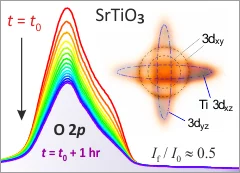Using angle-resolved photoemission spectroscopy, we show that the recently discovered surface state on SrTiO3 consists of nondegenerate t2g states with different dimensional characters. While the dxy bands have quasi-2D dispersions with weak kz dependence, the lifted dxz/dyz bands show 3D dispersions that differ significantly from bulk expectations and signal that electrons associated with those orbitals permeate the near-surface region. Like their more 2D counterparts, the size and character of the dxz/dyz Fermi surface components are essentially the same for different sample preparations. Irradiating SrTiO3 in ultrahigh vacuum is one method observed so far to induce the universal
surface metallic state. We reveal that during this process, changes in the oxygen valence band spectral weight that coincide with the emergence of surface conductivity are disproportionate to any change in the total intensity of the O 1s core level spectrum. This signifies that the formation of the metallic surface goes beyond a straightforward chemical doping scenario and occurs in conjunction with profound changes in the initial states and/or spatial distribution of near-EF electrons in the surface region. This project is led by the Spectroscopy of Novel Materials Group of PSI.


